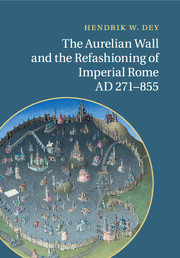Book contents
- Frontmatter
- Contents
- List of abbreviations
- List of figures
- Acknowledgements
- Introduction
- 1 Toward an architectural history of the Aurelian Wall, from its beginnings through the ninth century
- 2 Planning, building, rebuilding, and maintenance: the logistical dynamics of a (nearly) interminable project
- 3 Motives, meaning, and context: the Aurelian Wall and the late Roman state
- 4 The city, the suburbs, and the Wall: the rise of a topographical institution
- 5 Sacred geography, interrupted
- 6 The Wall and the “Republic of St. Peter”
- Conclusion
- Appendices
- Bibliography
- Index
Conclusion
Published online by Cambridge University Press: 19 May 2011
- Frontmatter
- Contents
- List of abbreviations
- List of figures
- Acknowledgements
- Introduction
- 1 Toward an architectural history of the Aurelian Wall, from its beginnings through the ninth century
- 2 Planning, building, rebuilding, and maintenance: the logistical dynamics of a (nearly) interminable project
- 3 Motives, meaning, and context: the Aurelian Wall and the late Roman state
- 4 The city, the suburbs, and the Wall: the rise of a topographical institution
- 5 Sacred geography, interrupted
- 6 The Wall and the “Republic of St. Peter”
- Conclusion
- Appendices
- Bibliography
- Index
Summary
So what, after all, is in a Wall? I hope the preceding thoughts about the Aurelian Wall, prime specimen that it is, between them indicate productive avenues of inquiry into what walls do and why we often care so much about them. As a case-study, the example of Rome has much to reveal, beginning (but only beginning) with the assorted mural phenomena that I have tried to outline over the course of this study. Together, these observations make a start at exploring a neglected structural constant in Roman history, by illustrating to some extent how the Aurelian Wall came to dominate physical and mental landscapes of the Eternal City like no other manmade feature, ever. I hope in the end to have laid plausible foundations for the following conclusions about the special relationship that arose between Rome and its enceinte, which might then become a useful point of departure for those interested in the wider implications of the Roman particulars.
Tactical efficacy – defense, in a word – was a necessary pretext for a structure as enormous and costly as the Aurelian Wall, an unobjectionable sanction for an initiative that would have otherwise been more galling in its grandiose uselessness than Nero's Golden House, for example. The Wall inevitably and inescapably had a pragmatic mandate, and for over fifteen centuries it remained a legitimate means of protecting and controlling the area it enclosed.
- Type
- Chapter
- Information
- Publisher: Cambridge University PressPrint publication year: 2011



